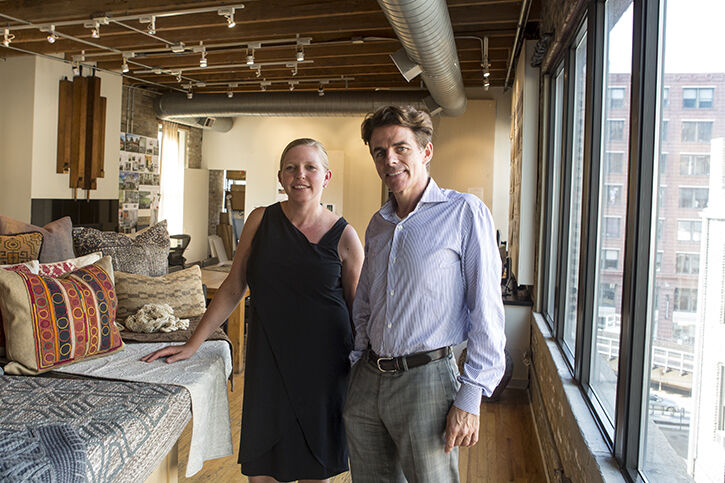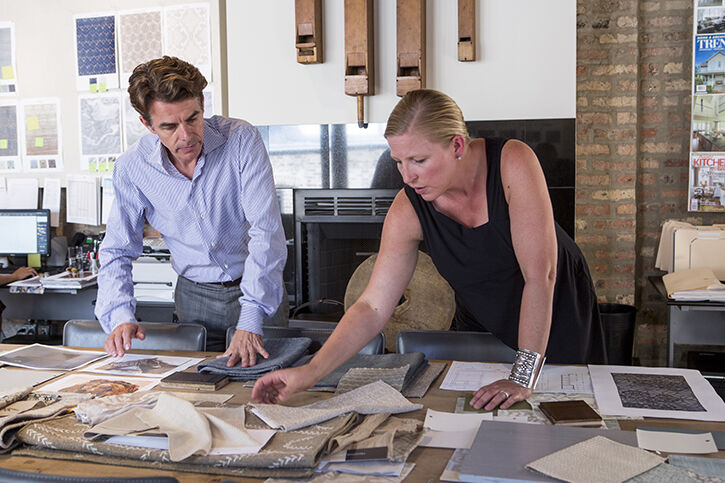
Business of Design

by Troy Pieper (MA 2015)
When Martin Horner and Shea Soucie studied interior architecture together at SAIC, they never imagined it would lead to the development of a successful Chicago design firm with clients around the globe. Both Soucie (BIA 1996) and Horner (BIA 1997) were undergrads together at SAIC, and, during that time, on an interior architecture study trip to Paris, their friendship solidified. After graduating, Soucie took a position at a Chicago design firm, and Horner got an internship there as well. Already working together in the professional world, says Horner, “That was when we started dreaming of the future.”
Starting their own firm in 2000 was a natural choice for both designers; Soucie’s father had been a contractor, and he helped her become interested in the architectural side of design. Horner’s father owned a furniture store, which often employed interior designers whose work got him interested in fabrics and furniture. “Our parents also taught us a lot about running a small business,” says Horner.
Soucie Horner began in an extra bedroom and a basement and grew quickly. By 2003, they had bought space in the River North neighborhood of Chicago, and now the firm has more than 20 employees. They began by designing high-end residential interiors on the north shore of Lake Michigan. Now they work with clients around Chicago, Los Angeles, New York City, and internationally. They attribute that growth to maintaining a reputation as excellent designers, as well as having business skills. “The ability to run a small business in the art of design is crucial,” says Soucie. “We often think of design as just the art form, but there is a lot of business skill that goes into each design project.”
It is one of the reasons the two also teach at SAIC. In their Professional Practices class, they discuss how to put together a portfolio and a résumé and “how not to be terrified in interviews,” Horner jokes. “You sell your art form no matter what your practice is,” Soucie says. “And somebody has to teach you how to look at your practice from more than just a purely aesthetic standpoint. As designers, we constantly look at how our art form creates value for our consumer.”
Horner is informed by his business background, having worked in finance for a decade before going back to school. He came to SAIC not only for its reputation as a top-tier design school but because he wanted to experience the art and design capital that is Chicago. “Chicago is a huge resource. You walk by architecture and design every day on the street.”
Soucie was interested in the School’s curriculum. “SAIC really focuses on the conceptual part of design,” she says. “I felt if I could be taught how to think about design, I could figure out the practical skills, which are what other design schools seem to focus on.”
The two host regular salon discussions for people working in the field, whether they are architecture writers, designers, property developers, or publicists. In one discussion, former SAIC president Tony Jones talked about teaching students “to think,” Soucie says, versus teaching practical skills. “Drawing is one thing,” acknowledges Horner, “but you have to be able to think and conceptualize something that you can sell to a client.”

SAIC faculty members, many of whom are practitioners working in the design industry in Chicago, are where Horner found value as a student. “There are so many people working in the field in Chicago, and the School connects students to them in several ways.” Now that he and Soucie are themselves SAIC design instructors, they can provide the same benefits to students. But there are benefits for them as designers, as well. “Students are not yet inhibited by budgets and other things that can contain their ideas later,” says Soucie. “To be able to see those new ideas is a great way for us to stay fresh and make contact with potential new employees.”
Teaching is one way Soucie and Horner stay on top of the changes they have seen in the design world over the years. One of the biggest changes has been the influence of technology on design. “It’s sort of pushed space and how people use their homes,” says Soucie. The other big change is greater collaboration between designers of all kinds. European firms are more comfortable with the notion of collective design, says Horner. Interior designers work with product designers, lighting designers work with architects, and so on. “We’re starting to see that more here, too. We share employees with different firms, and we call each other when we’re looking for information or resources.”
Soucie attributes some of that willingness to collaborate and move among different disciplines to SAIC’s weaving together of different practices. “All of it goes back to the core principles of design, but at an interdisciplinary school, you get to see all of the perspectives people have, and this is happening more and more in the real world.” Soucie and Horner have indeed branched out both in their work as artists and in business. A few years ago, they began partnering with real estate developers to put together entire conceptual plans for the interiors of large developments. And recently they launched Soucie Horner Collections, a signature line of home furnishings, hand-woven rugs, and lighting.
Their goal, Horner says, is to design “something beautifully put together that’s perfect for the place and the people who living there.” There is no Soucie Horner stamp on the homes they design. Just as their body of work describes how Soucie and Horner’s practice as designers has changed, each of the homes they design, says Soucie, is “a scrapbook of the people who live there.”
